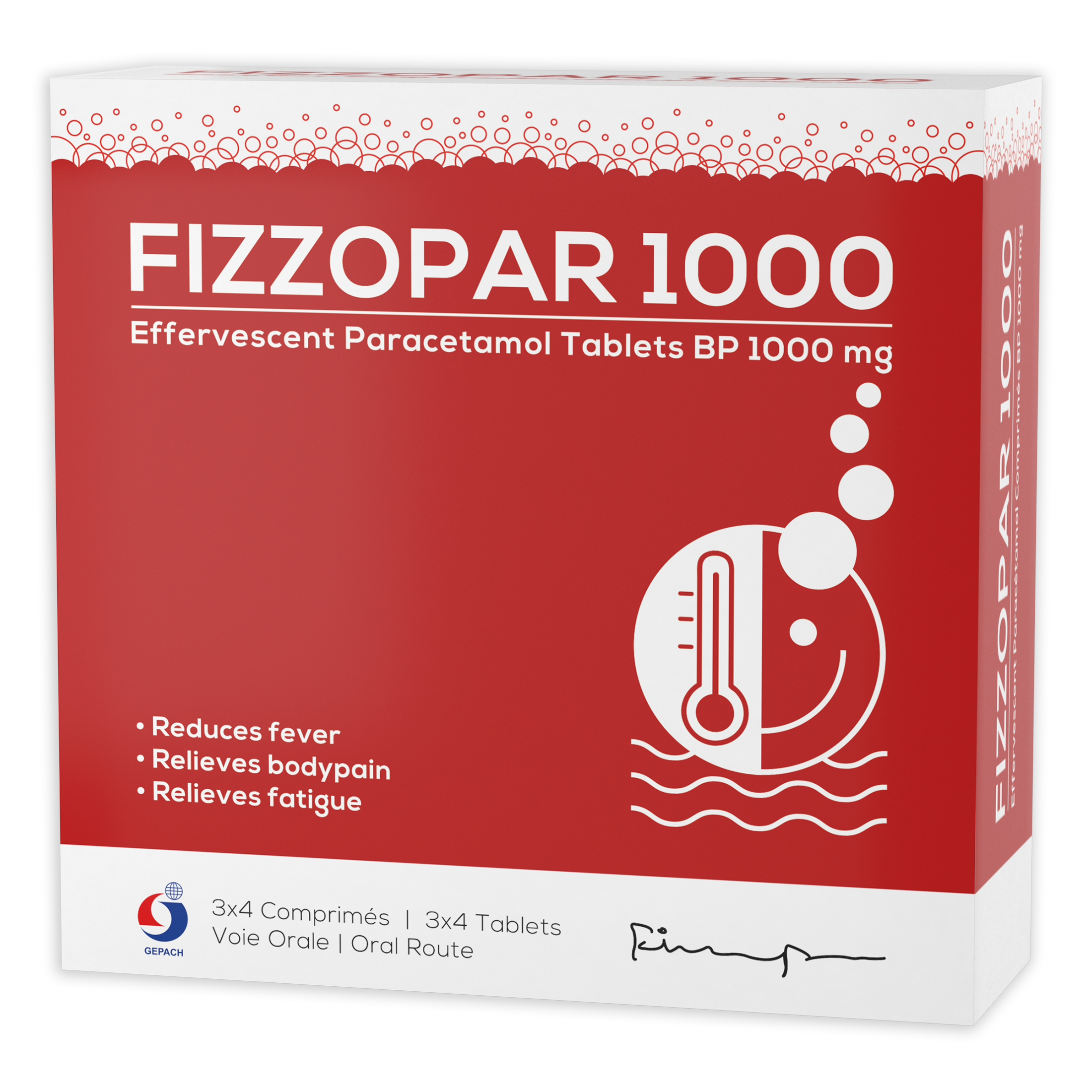Description
FIZZOPAR (Soluble Paracetamol Tablets BP) is a centrally acting analgesic and antipyretic with minimal anti-inflammatory properties. It is used for the relief of mild to moderate pain including headache, migraine, neuralgia, toothache, period pain and pain caused by rheumatism. It is also used to relieve the symptoms of colds, flu and sore throats.
FIZZOPAR exerts its analgesic activity by inhibiting prostaglandin synthesis in the central nervous system (CNS) and to a lesser extent, through a peripheral action by blocking pain-impulse generation. It also exerts antipyretic activity by acting centrally on the hypothalamic heat-regulation centre to produce peripheral vasodilation resulting in increased blood flow through the skin, sweating and heat loss.
Composition
Each effervescent tablet of FIZZOPAR 500 contains:
Paracetamol BP………….500 mg
Each effervescent tablet of FIZZOPAR 650 contains:
Paracetamol BP………….650 mg
Each effervescent tablet of FIZZOPAR 1000 contains:
Paracetamol BP………….1000 mg
Recommended dosage & Administration
Adults: Elderly and Children over 12 years: One tablet every four hours upto a maximum of 4 tablets in any 24-hour period.
If symptoms persist for more than 3 days, consult your doctor.
Directions:
Allow the tablet to dissolve completely in a glass of water. Drink immediately after complete dissolution.
Indications
- Symptomatic treatment of mild to moderate pain and / or febrile (feverish) conditions.
- Symptomatic treatment of osteoarthritis pain.
Pack size
4 Effervescent tablets packed in Alu-Alu Strip & 3 such Alu-Alu strips are to be packed in a carton along with printed leaflet.
FAQs
1) Does Paracetamol linger long after taking it, causing harm to one’s body?
When taken as directed, a dose of Paracetamol, the active ingredient in Fizzopar, is eliminated from the body within 24 hours in most healthy people. The approximate mid-point elimination half-life of paracetamol (at 2.5 hours) is shorter than that of the caffeine (65mg) in a typical cup of coffee after oral administration (at 5 hours) in most healthy adults. This indicates that a healthy body takes a longer time to eliminate the caffeine in a typical cup of coffee as compared to paracetamol.
2) Can you become dependent/ addicted to Paracetamol?
Paracetamol does not cause dependency and is non-addictive. Fizzopar is suitable when used as directed. If symptoms persist, please consult your doctor or pharmacist.
3) Overtime does one have to take larger doses because your body builds up a tolerance to paracetamol ?
While treating common types of pain, the body is very unlikely to build tolerance or resistance to paracetamol and should work at the same dose each time. Consumers are advised to seek medical advice if symptoms persist beyond the recommended period on the label.
4) What is Acetaminophen?
Acetaminophen, also abbreviated as APAP, is called paracetamol in other countries. It is a safe and effective pain reliever that benefits millions of consumers. There are about 600 products that contain acetaminophen, including cough and cold products and combination pain reliever/sleep aids. It also is an ingredient in many prescription pain relievers.
5) What does Paracetamol have to do with my liver?
Your liver helps break down and remove many chemicals or drugs that enter your body. Too much paracetamol can overload your liver’s ability to process the drug safely and eliminate the breakdown products. Under certain circumstances, particularly when more paracetamol is ingested than is recommended on the label, a toxic breakdown product accumulates in the liver and can result in serious damage.
6) What are the symptoms of liver damage?
Paracetamol can cause liver injury through the production of a toxic metabolite. The body eliminates acetaminophen by changing it into substances (metabolites) that the body can easily eliminate in the stool or urine. Under certain circumstances, particularly when more paracetamol is ingested than is recommended on the label, more of the harmful metabolite is produced than the body can easily eliminate. This harmful metabolite can seriously damage the liver.
The signs of acute liver toxicity, which can result from an overdose of acetaminophen, include:
- Nausea and vomiting, sometimes within the first 12 to 24 hours after ingestion
- Abdominal pain
- Abnormally yellow skin and eyes, dark urine, light-coloured stools, and loss of appetite
- Renal failure
- Pancreatitis
The signs can be similar to flu symptoms and might go unnoticed for several days if you believe they are related to a cold or flu you might already have. Additionally, there might be a brief 12 to 24-hour period in which no symptoms occur, followed by vomiting, abdominal pain, and other symptoms of liver failure.






